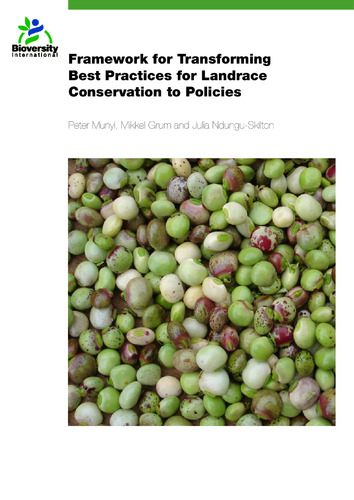Framework for transforming best practices for landrace conservation to policies
Traditional farming systems and conservation of local cultivars and associated indigenous knowledge are under threat and growing pressure resulting in genetic erosion of crop diversity. These systems are an essential component of sustainable crop production, household income and human nutrition for many of the poor farmers found in fragile semiarid ecosystems of Sub-Saharan Africa (SSA). With the signing of the Convention on Biological Diversity (CBD) in 1992, in situ conservation for crops and their related genetic resources has been given prominent mention in global and national policies for biodiversity conservation. In situ strategies are an important and complementary component of the overall agrobiodiversity conservation efforts that aim to conserve not only crop genetic resources but also crop evolutionary processes. However, policy support of the science and practice of in situ conservation, lag behind CBD commitment in much of SSA. The need for activities on in situ conservation of plant genetic resources is emphasized in the CBD and in Agenda 21. Article 2 of the Convention specifically includes reference to domesticated or cultivated species. This is also anticipated in Article 8, which requires signatory nations to “preserve and maintain knowledge, innovations and practices of indigenous and local communities embodying traditional lifestyles relevant for the conservation and sustainable use of biological diversity …” Agenda 21 reflects this commitment to in situ conservation as an essential component of sustainable agriculture, and in Chapter 14, notes the need for establishing programmes and policies to strengthen in situ conservation. In its second meeting, the Conference of the Parties to the CBD (COP 2) identified implementation of Article 8 of the CBD as a high priority and reaffirmed the importance of regional and international cooperationfor the implementation of this Article. It also stressed the importance of the exchange of relevant information and experience among all stakeholders on measures taken for its implementation (Decision II/7 of COP 2). Many national PGR programmes in SSA are unable to meet their obligations towards in situ (more specifically on-farm) conservation as stated in the CBD and the GPA because of ineffective enabling of national policy environments that do not support traditional farming systems and in situ conservation on-farm. The countries involved in the project were Benin, Burkina Faso, Ghana, Kenya, Malawi, Mali, Uganda and Zimbabwe. Through case studies, the project analysed farming systems in semi-arid ecosystems in these countries, focussing on how these systems supported the conservation of landraces of local and global significance. The methodology described in the present publication was designed within this project to draw out ‘best’ practices on how landraces have been incorporated into farming systems and/or national agricultural policies and biodiversity conservation strategies. On one hand, the farmer or resource user determines what makes the practice the ‘best one’, and they base their choices on a survival strategy or utilitarian point of view. On the other hand, the scientists on the project primarily judged how effective the practices are in conserving agrobiodiversity at different levels. The project attempted to reconcile the two views in developing frameworks for the determination of ‘best practice’.

